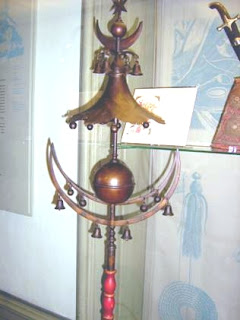 |
| The Rehearsal |
Taking the time to examine historic objects brings out details that imbue the articles with interest. The above photo is from an 1870’s stereoview and shows a typical genre scene of a musical rehearsal, but a second glance shows that the photographer recorded something unusual.
There are four male musicians accompanied by a woman playing a keyboard instrument. Two of the men are playing a cornet and a trombone, both perfectly ordinary. One is playing an early tuba, highlighted in a blue square, but the most interesting is the performer on the right, highlighted in red, who is playing the Turkish crescent, also known as the Jingling Johnny.
 |
| The jingling Johnny blends in with the elaborate sconce behind |
The Turkish crescent was a percussion instrument, basically a pole hung with bells. Mostly a flashy parade instrument, it was meant to be shaken or twisted to ring the bells. It is still made and used to some extent, so is not entirely obsolete. This one is very typical, with a crescent on top, conical “hat” below (yet another name is chapeau chinois, or Chinese hat), and a larger crescent below that, all hung with bells. Their polished brass and exotic shape make them popular with musical instrument museums, as with these examples:
 |
| Turkish crescent in Boston MFA |
 |
| Example in Basel |
 |
| and one in Germany |
The Turkish influence was popular in Western music starting from the 18th century—think of Mozart’s Rondo alla Turca. Many pianos of the period had Turkish or Janissary stops which controlled various bells, cymbals and drums.
 |
| Notice the very wide conical bell on this tuba, with almost no flare |
Most mechanized brass instruments were developed in the 19th century, but this tuba seems primitive even by the standards of 1870. It is still shaped very much like the earlier ophicleide, from which it was developed. Notice that the bell end is simply a wide truncated cone, with very little flare to it. The tuba in this photo resembles the Moritz tuba, which Phillip Young remarks is noted for its early primitiveness.
 | |
| Ophicleide, early brass bass instrument, by Guichard, MFA |
 |
| Early tuba by Moritz |
 |
| Early American tuba by Gilmore |
 |
| More modern tuba by White (made in Cleveland!) |
 |
| This baritone also shows the typical modern brass profile |
Here is the entire stereoview. (The two halves were taken at slightly different angles, and appear three-dimensional when viewed through a special viewer.) The image as a whole helps tell us how people spent time and entertained themselves 140 years ago, playing instruments, forming home music ensembles, and even looking at stereoviews. An interest in musical instruments lets us notice the individual elements of this photo, with the result that two early and unusual instruments are brought into focus.
===============================================================
Images:
MFA crescent, Guichard ophicleide and Gilmore tuba courtesy Boston Museum of Fine Arts, www.mfa.org.
Basel crescent courtesy HISTORISCHES MUSEUM BASEL, www.hmb.ch.
Moritz tuba from The Look of Music, by Phillip Young.
White tuba courtesy U. of Michigan Stearns Collection, www.music.umich.edu.
===============================================================















